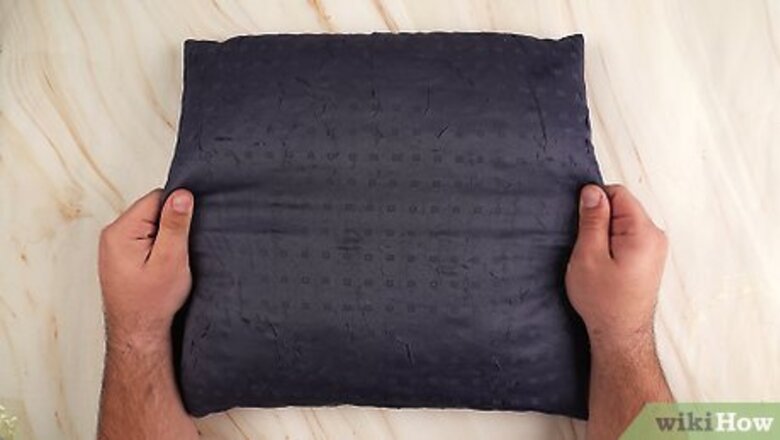
views
Fluffing Pillows by Hand
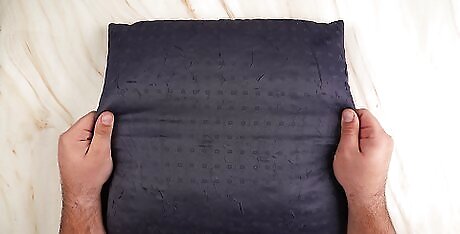
Squish and stretch the pillow like it’s an accordion. Grab opposite ends of the pillow in each hand. Push the ends of the pillow in and out as if you were playing a squeeze box or accordion. Reshape the pillow with your hands so it sits correctly on the bed and fits into a pillowcase. This method will break up any clumps in the fill and restore the air in the pillow. The accordion method works especially well for down pillows that need a fresh fluff.
Massage the pillow, especially if it’s lumpy. Find the lumpy areas of the pillow that you’d like to target. Use your fingers to massage out the lumps in the fill, using the same motions you would to knead dough. Fluff the pillows again using a different method to redistribute the fill. Massaging works especially well for down alternative pillows with lots of lumps.
Clap your pillow together diagonally. Hold the opposite diagonal corners of your pillow, one in each hand. Bring your hands together quickly so that your pillow “claps” together. Avoid clapping too hard, as too much force could make your pillow even flatter.
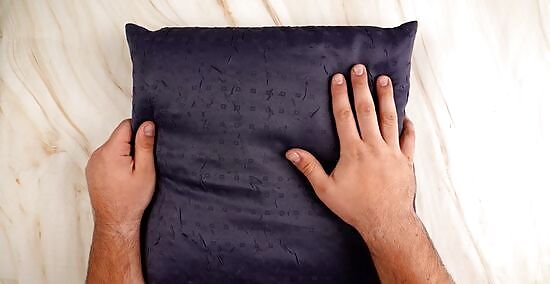
Punch the pillow repeatedly. If the pillows aren’t being weighed down by moisture (e.g. they’re compressed due to the weight of your head rather than a lot of sweat or oils), you can fluff them by hitting the sides simultaneously with your fists. If you have a feather pillow, hit it very lightly, as the fill material is very light. Then, Take your pillow and whack it on your bed a few times to even it out.
Release and catch the pillow. Hold the pillow at the top. Make sure the pillow is going up and down, not side-to-side like you have it when you are sleeping. Move your hands down to about the center of the pillow. Quickly squeeze, let go, and catch the pillow. Repeat this action about five times. After squeezing the pillows, shake them strongly, put them on your bed again, and then beat the pillow with your flat hand on every side.
Fluffing Pillows in the Dryer
Place two pillows together in a dryer. Place the pillows on opposite sides of the dryer so that the drum is balanced and can spin properly. You can use this method when pillows are fully dry, or after you’ve just washed your pillows and let them air dry for 1-2 hours until mostly dry. However, the pillows will come out fluffier if they start the cycle fully dry. If your pillows are dry before going in the dryer, start with a 10-minute cycle on medium to low heat. If your pillows are slightly damp from a wash, run them through a full dryer cycle on the lowest temperature setting available. Check the pillow’s care label to make sure it’s dryer-safe before using this method. If it can be machine-dried, you should still check to see if the fill material requires a low heat setting or any other special precautions to avoid damage.
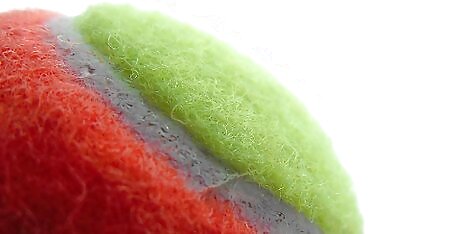
Put pillows in the dryer with a tennis ball in a tube sock. Place a tennis ball in a tube sock and tie the sock at the end. Load the pillows into the dryer with the tennis ball. The movement and agitation of the tennis ball will help your pillows dry evenly and retain extra volume. If you don’t have a tennis ball, you can also use knotted clothing, clean towels, or a dry stuffed animal. This method works best for down pillows that have some clumps in their filling. The agitating tennis bell will help work out some of those clumps. You can also use dryer balls to help keep your pillows fluffy in the dryer, but most dryer balls won’t be heavy enough to act as an agitator and break up the clumps in your pillows.
Fluffing Pillows with Sunlight & Fresh Air
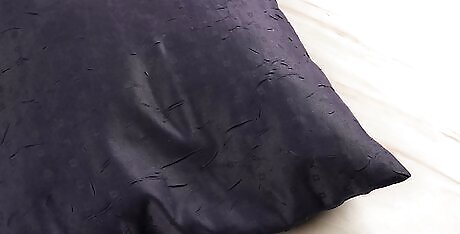
Leave the pillow out in the sun for 3-4 hours. Remove the pillowcase or other protective barrier and place the pillow in a clean, dry, and sunny spot. Leave the pillow to lay in the sun until it’s completely dry, usually 3-4 hours. Along with fluffing your pillow, the warmth, heat, and ultraviolet light of the sun can help remove foul odors and kill bacteria. Usually, pillows lose their volume because of moisture, so the sun can help dry them and increase fluffiness. This method is especially useful for memory foam pillows and other solid fills. Keep in mind that this method should only be used if the weather is warm and dry.
Hang your pillow on a clothesline. Pin the pillow in a spot that receives a lot of sun. Let the pillow dry outside for several hours so it has time to expand and fluff up. The clothesline method also allows fresh air to flow into the pillow, which will help fluff the fill.
Understanding Why Pillows Go Flat
Pillows go flat due to weight, moisture, accumulated dirt, and dead skin cells. After sleeping on a pillow for a long time, especially in the same sleep position, the pillow will eventually compress under the weight of your head. Pillows also collect skin cells and natural oils as you sleep, which can weigh down the fill and attract dust mites. Moisture, in general, is also easily absorbed by pillows. The moisture from your sweat or sleeping environment may weigh down the pillow and reduce its fluffiness.
Certain types of pillow fillings flatten more easily than others. Down and down alternative pillows compress easily and require daily fluffing. Shredded memory foam and shredded latex pillows also require regular fluffing. On the other hand, solid foam, solid latex, and buckwheat pillows don’t need regular fluffing. However, they might need a little refresh from time to time.
Signs You Need to Fluff or Replace a Pillow

Your pillow fails the fold test. Fold your pillow in half. Note if it immediately springs back or takes a second before laying flat again. If your pillow stays folded or is slow in springing back, your pillow needs to be fluffed or replaced.
You have inexplicable allergy symptoms. You may experience an increase in allergy symptoms due to your pillow. If a pillow hasn’t been cleaned, fluffed, or replaced in a long time, it likely has a build-up of dirt and dust particles. These particles may be causing you to sneeze or have a stuffy nose that feels like allergies.
You’re always stacking or readjusting your pillows. You shouldn’t have to sleep with multiple pillows or constantly adjust your pillow throughout the night to be comfortable. If your pillow has gone flat to the point that you need more pillows to compensate for it, it’s time to replace it or give it a good fluff.
Your pillow is putting pressure on your neck and shoulders. If you’re constantly waking up with neck or shoulder pain, this is a sign that your pillow is sitting at the wrong height. It may be putting your neck out of alignment, leading to your pain in the morning. Similarly, your neck being out of alignment may restrict blood flow to your arms and hands. If you’re waking up with your arms feeling numb or tingly, this is a sign that your pillow needs to be fluffed or replaced.
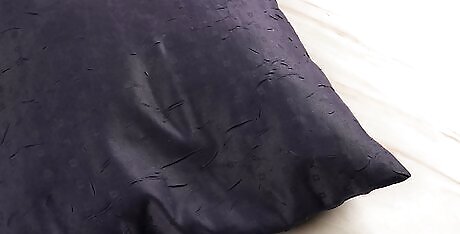
Your pillow remains flat despite your fluffing attempts. Sometimes, pillows have just run their course. If you’ve tried all the fluffing methods above and nothing seems to be working, it may be time to throw in the towel and replace the pillow. Another sure sign that your pillow needs to be replaced is that it has odors, stains, or a persistent lumpy fill. Experts suggest replacing pillows every 4-6 years, primarily for the removal of dust mites. Some pillows can last longer than others based on quality and fill. More affordable, polyester pillows only last about one year. Latex pillows, on the other hand, can last around 5 years, while memory foam and down pillows last for 2 to 3.













Comments
0 comment